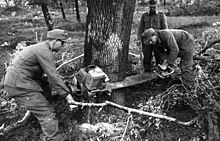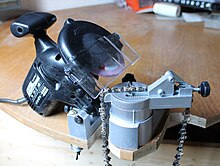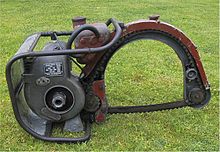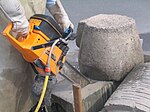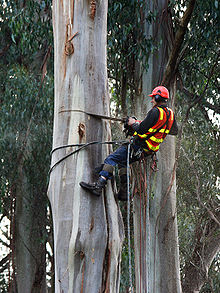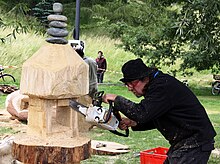chainsaw
The chain saw (also saw or colloquially spruce forest moped or scooter) is one with a gasoline engine - or electric motor , with compressed air ( pneumatic ) or with oil pressure ( hydraulic ) driven saw , the cutting part of the saw chain is. The most common design is the hand-held chainsaw for wood and forest work , often simply called a chainsaw . Essential parts of this article relate to this type, rarer types are listed under special types .
history

The technical principle of the saw chain, which runs around a rail, was already used in 1830 by the Würzburg doctor Bernhard Heine for the osteotome to saw bones.
As early as 1900, with the first so-called sawing machines, the purely manual work that had prevailed in the forest up until then was replaced.
In the 1920s, two-man machines were developed that were extremely heavy and, according to today's ideas, complex to operate (see section on special designs ). These devices were used to cut the trunks of already felled trees into sections.
The first petrol-powered chainsaw that was tested and used in forestry was the Sector woodcutter , it was used for felling and cutting to length. Probably the oldest photo of the use of a chainsaw in Germany around 1920 can be found in the book Forest History (2006). The inventor Emil Lerp , founder of the Hamburg company Dolmar , brought the first series-produced petrol-powered chainsaw onto the market in 1927 (Type A) . The saw had to be operated by two people and could only make vertical cuts.
Stihl built the first chainsaw with an electric motor for use on cutting stations (where logs are cut into pieces) in 1926.
In the further development chain saws were built with which the rail could be swiveled by 90 degrees. With these saws lying wood could be cut to length (vertical cut) and also standing wood (i.e. trees) with a horizontal cut. The one-man petrol chainsaw DOLMAR CP , produced from 1952, had such a swiveling rail. In order to save the mechanically complex swiveling device of the rail, chainsaws with a carburettor that could be swiveled by 90 degrees were temporarily built, e.g. B. in the GDR the Faun from WERUS.
Ultimately, however, it was the membrane carburettor developed in aircraft construction that made it possible to operate the chainsaw completely independently of the position and led to the development of the one-man chainsaw (EMS) that is in use today at the end of the 1950s. The first models of this type built in Europe were the Dolmar CF in 1957 , the Rex from SOLO in 1958 and the Contra from Stihl in 1959 . The one-man chainsaw significantly increased the productivity of the wood harvest. The first is not tuned out rates in forestry led transitional to a high income for forest workers , as far as the 1990s, the timber harvest was basically the hired house ( group chord paid).
construction
Housing and motor
The drive motor is located in a chainsaw housing to which the two handles are also attached. Usually it is a two-stroke gasoline engine or an electric motor . A pull starter is often available to start the petrol engine , similar to a lawnmower. Four-stroke engines are uncommon because it is difficult to implement a position-independent lubrication with them, while the mixture lubrication of two-stroke engines is position-independent from the start.
Rail and chain
An elongated metal sheet, the rail (also known as a sheet or sword ) is attached to the front of the housing . A groove is worked into the edges of the rail , in which a metal chain - the saw chain - runs around the rail. A roller (sprocket) is usually attached to the front tip of the rail to reduce friction here. The tension of the chain is adjustable.
The chain is equipped with saw teeth on the outside and is driven by the motor via a centrifugal clutch at the rear end of the rail . To reduce wear on the bar, the chain must be constantly lubricated with oil. When sawing, part of the oil is thrown off. The chain must be sharpened sooner or later, depending on the use. The incisors become blunt very quickly, especially when the wood is dirty or iced up, when cutting into foreign bodies and into the ground. Special chain sharpening machines or files are used for sharpening .
Chains are available in different cutting geometries and different pitches, depending on the cutting performance and quality (forestry, construction, hardwood). The forms of half chisel and full chisel are widespread. Carbide chains with carbide plates soldered onto the cutting teeth are available from various manufacturers . These chains have a long service life of normal chains and can also cut metals or aerated concrete blocks to a limited extent. But they need a higher engine power and can only be ground with special diamond wheels.
Start relief
Various technical constructions enable the chainsaw to be started easily, especially after it has been idle for a long time.
This includes:
- ElastoStart (Stihl) or ISI Start
- A spring or a rubber element in the starter handle (Stihl) or in the winding spool of the reversing starter ( Echo ) dampens the force peaks in the starter rope that occur when the saw is started.
- One push start
- A spring is pre-tensioned via the normal reversing start and triggered by pressing a button; this will start the chainsaw.
- Primer
- A plastic ball that can be used to manually pump fuel into the carburetor
- Automatic start (Stihl)
- For some time, Stihl offered a saw with an automatically controlled starter flap. Due to the complex structure and lack of market acceptance, this technology disappeared from the market.
- ZIP easy start system
- By pressing a decompression valve, part of the compressed mixture can escape from the cylinder when starting, which reduces the pulling force on the starter rope.
Special designs
- Joinery chainsaw
- Chainsaw with support for precise carpentry work in joinery . It is partially equipped with special chains for high-quality cut surfaces.
- Mining chainsaw
- Because of the risk of explosion, this type of saw was operated with compressed air. It was also used on ships.
- Concrete chainsaw
- Often hydraulically operated and water-cooled chainsaw for vibration-free cutting of concrete rubble, for example after earthquakes . For this, the saw, which is mainly used by the technical relief organization , and less often by the fire department , is equipped with a diamond-set chain. Also used in restoration, sculpture and construction.
- Bow chainsaw
- Chainsaw with an electric or gasoline and diesel engine in which the chain is guided over the trunk in a bracket. It was primarily used as an electric saw in sawmills, as a gasoline saw in the forest for cutting to length. The type designation at Dolmar was CB35, CB50 and CB65.
- Pole pruner
- Small chainsaw on a long, mostly telescopic handle, is used to cut high branches.
- Hot saws
- Special motor chain saws for competitions like the Stihl Timbersports .
- Rescue saw or rescue saw
- Specially equipped saw for fire brigade and THW with reinforced curb chain and adjustable depth stop. It can also be used to cut through metals (e.g. trapezoidal sheets or metal walls in sandwich construction) thanks to the reinforced chain.
- Top handle chainsaws
- Formerly also known as one- hand chainsaws : These are relatively small special chainsaws. With the top handle saw, the throttle grip, which is otherwise located at the rear, is attached to the top of the saw in order to achieve a compact design. Operation with one hand is advisable, but is prohibited in accordance with the accident prevention regulations (UVV), as the saw's safety devices no longer respond in an emergency. These saws can do a good job in tight spaces. This saw is well suited from scaffolding and work baskets. Use with one hand, however, is only permitted for tree care in special cases. The tree climber must have completed special training in tree climbing.
- Two-man chainsaw
- As the name suggests, a saw that, in addition to the saw operator, also needs an assistant at the end of the saw bar. The two-man chainsaw is, so to speak, the forefather of today's chainsaws. Due to its heavy weight and the up to two meters long rail, it was only possible to saw with two people. Today, some of these saws are still used as transportable sawmills in the jungle regions of Africa and South America. In Europe, they are considered historical collectibles and are only used at collectors' meetings. However, there are also modern saws that are equipped with an additional handle on the tip of the rail due to their particularly long sword.
Areas of application
- Forestry and tree care
- In forestry , trees are felled and delimbed with chainsaws. To do this, a notch is first cut to determine the direction of fall. Then a felling cut is made on the opposite side , in which a wedge is attached and the tree is "wedged", i.e. felled. In order to encourage a certain direction of fall, a horizontal force can be applied (usually by rope).
- In tree care : Use for branch shedding and cutting .
- Construction work
- On the construction site , carpenters in particular often use chainsaws as beam saws .
- Technical assistance
- At the fire brigade or the THW , chain saws are used in technical assistance .
- Competitions
- Athletes from all over the world compete against each other in forestry competitions and simulate cutting to length and felling with a chainsaw and ax (see Stihl Timbersports ).
- art
- Chainsaws are also popular with wood sculptors and ice sculptors (see ice sculpture ).
Accident protection
Technical accident protection
To reduce the risk of accidents, modern chainsaws are equipped with various safety devices:
- Centrifugal clutch
- It means that the chain is only driven from a certain engine speed. The chain stands still when idling. In addition, the centrifugal clutch prevents the engine from stalling unnecessarily often when the chain brake is overloaded or the chain brake is triggered (see below).
- Chain brake
- The front hand guard located in front of the handlebar serves as a trigger for the chain brake. The front hand guard is connected to the clutch bell via a mechanism. By this mechanism comprising toggle levers , springs, and a brake band, is in the non-return of the saw (and activate the chain brake by the front hand guard) brought the chain within a fraction of a second to a standstill. Additional devices can trigger the chain brake when the throttle is released. The braking power of the chain brake is higher than the engine power, so that even an engine running at full throttle can be braked. The chain brake consists of a brake bell, which also serves as a coupling element. The brake band is drawn when the hand guard is triggered and thus stops the chain. From the inside, the centrifugal clutch presses against the bell and drives the chain. Due to the design, the bell is turned inwards on some models (Stihl) on some outwards (Husqvarna).
- Claw stop
- The claw stop makes it possible to fix the engine block to the wood when sawing with the chain running in . Uncontrolled knocking out of the saw is thus made more difficult. It can also use leverage to develop pressure on the saw chain.
- Chain catch bolt
- This bolt is located on the underside of the housing below the saw rail. If the chain breaks, the chain locking pin reduces the risk of the chain swinging under the engine block to the saw operator. If the chain dips under the saw, it may also hit the rear handle, which is therefore widened and provides impact protection. The catch bolt is usually made of aluminum in order not to damage the chain when it is caught. The bolt can usually be replaced; But there are also saws with a firmly cast catch bolt in the side cover.
- Hand protection
- The rear hand guard protects the hand from below against branches, the rough trunk surface (when delimbing) and possibly a torn, twisting chain. Therefore this is widened.
- Saw bar and chain
- The saw chain and bar form a protective element if it is a saw bar with a small tip radius and the chain is a so-called low profile chain. In this combination, the risk of kickback is reduced. This combination is usually used for small and hobby saws.
- Throttle lock
- It is on the upper side of the rear handle, on the underside of which the actual throttle is located. Without pressing the throttle lock, the throttle cannot be operated (is locked). The engine then only runs in idle, the chain does not run. In addition to making improper handling more difficult, the throttle lock prevents unintentional acceleration, e.g. B. through branches.
- Vibration damper
- The vibrations of the early models caused circulatory disorders in forest workers, which could lead to permanent numbness of the fingers - an occupational disease known and recognized as white finger disease. In modern machines, the transmission of the vibrations to the saw operator is largely absorbed by anti-vibration elements.
- Grip heating
- The handle of some models is heated so that the saw can be operated safely even at extremely low temperatures. In addition to reducing vibrations, the heated grips also make a significant contribution to protecting the health of the operator. The heated grips are powered by a generator. This heater warms the front and rear handles and often the carburetor (anti-icing protection).
Protective equipment and work technology
When working with chainsaws, it is essential to wear personal protective equipment because working with chainsaws is very accident-prone. In Germany, which is considered as in many other countries for lumberjacks chainsaw safety clothing or similar provisions, consisting of protection trousers , helmet with visor and hearing protection , safety shoes with a protective layer and others.
The following safety rules must always be observed:
- Adjust the chainsaw
- Always tension the saw chain correctly before starting work. The correct setting of the idle speed is important to avoid the one hand the chain already in idle moves along, but then the engine does not die due to low speed.
- Winter operation
- At low temperatures around freezing point, saws should be switched to winter operation. For this purpose there are elements that are clamped onto the starter housing from the outside; this reduces the supply of cooling air. Another element is a flap in the top lid, as it allows warm air to flow from the engine to the air filter and carburetor; this prevents the carburetor from icing up. There are also nylon filters for some saws (e.g. Husqvarna) that do not ice up (felt-covered filters are used in warm weather). Winter measures must be reversed when temperatures rise again.
- Start the chain saw
- Place the chainsaw on the ground and engage the chain brake. To start the chain saw, press firmly on the ground with your left hand on the front handlebar and with your right foot in the rear handle under the machine's throttle. Alternatively, the heel of the right foot can also be placed on the hand guard to the right of the rear handle. Now pull the starter rope with your right hand.
Alternative for light chainsaws: engage the chain brake and clamp the chainsaw firmly between your knees or thighs with the rear handle. Hold the handlebar with your left hand and pull the starter rope with your right hand. On carburettor machines, when the engine is cold, pull the choke lever until the engine stutters a few times. Then slide the choke back and tighten the saw again. For saws with an electronically controlled carburetor, this is only tightened. - Hold chainsaw
- The chainsaw must always be used with both hands when working, with the left hand grasping the front handle, which is closer to the saw bar. Chainsaws are always designed for right-handers. There are no left-handed models . The left hand grip should be positioned so that the chain brake is released cleanly.
- Use chain brake
- The chain brake must be engaged after every cut. The easiest way to achieve this after making a vertical cut is to turn the left wrist briefly forward. Only then change the position for the next cut. Now place the sword on the trunk and pull the brake lever towards the handle with your left hand, thereby releasing the chain brake. This will prevent serious injuries if you fall on the chainsaw.
- Avoid kickback
- Maintain correct cutting lines, guide the chainsaw so that accidental contact is safely avoided.
- Keep the danger area clear
- Do not stand with your head, body or legs in the area behind the saw chain so that if the chain breaks it cannot hit the machine operator.
- Maintain working height
- Working with the chainsaw above shoulder height is prohibited, as the force is no longer sufficient to safely operate the chainsaw. This also applies to small and very small chainsaws. The general rule of chainsaw courses is “tip of the rail equals the tip of the nose”.
Accident prevention regulations (UVV)
According to the general provisions of the UVV in Germany, the use of chainsaws (in the sense of the regulations for safety and health protection (VSG) are chainsaws driven by internal combustion engines) in the commercial sector and in some state forests in some federal states requires a "suitability" or a certificate of expertise VSG 4.2 ahead.
This technical instruction is colloquially called chainsaw , chain saw guide , chain guide or in attached combination with ~ proof , authorization ~ or ~ translucent designated and includes, but is for German fire brigades (training course (mksf)). The training takes place through the forest work schools, forest offices or private course providers. The fire brigade and the technical relief organization have their own trainers and courses. The acceptance of the training, if it takes place in the context of a craft vocational training or further education, is carried out by a representative of the professional associations (such as the professional association for wood and metal for joiners, carpenters and metalworking professions) or a representative.
- For chainsaws used commercially, an annual safety check, the UVV test (according to the guidelines of the employers' liability insurance association) is mandatory, for electric chainsaws in conjunction with the VDE regulations.
Chainsaws and environmental protection
The lubricant ( saw chain oil ) supplied to the chain via the oil pump is mainly thrown off or sticks to the sawdust. For a long time, therefore, oil that is biodegradable in the short term ("bio-chain oil", e.g. based on rapeseed oil ) has been used or prescribed to an increasing extent . Furthermore, modern chainsaws usually have an adjustable oil pump so that the lubricant requirement can be adapted exactly to the rail length used. In modern chainsaws, the oil pump is driven by the internal centrifugal clutch in order to avoid unnecessary losses and contamination when idling.
Two-stroke engines , as they are normally used in chainsaws, have less favorable emissions than four-stroke engines . The two-stroke engine releases a considerable part of the fuel (20 percent flushing loss) back into the environment unburned. With continuous use this is a great burden both for the environment and for the saw operator. For this reason, benzene-free special fuel was developed for chainsaws (post-refined alkylate petrol), which produces 90 percent fewer pollutants than conventional petrol. However, it is considerably more expensive than gasoline. In Baden-Württemberg, the use of alkylate petrol is also mandatory for self- recruiters.
Power saws powered by a (more environmentally friendly) four-stroke engine are under development. The four-stroke engine, however, is fundamentally more complex and significantly heavier than a two-stroke engine with the same power output.
- The manufacturer Komatsu Zenoah from Japan has developed and installed a drive called a flushing reservoir motor ; the concept is marketed under the name Strato charged Engine and forms the basis for all other flushing reservoir motors from various manufacturers.
- The manufacturer Dolmar has already developed a series-production four-stroke engine for chainsaws and is preparing to launch it.
- The Italian manufacturer EMAK has developed an engine with diaphragm-controlled direct injection and made it ready for series production; it is already available on the market and is currently the only motor of this type on the market.
- In 1988 the Stihl company brought a catalytic converter onto the market that made a significant contribution to reducing pollutants in the exhaust gases. It is a platinum-coated metal catalyst from Emitec . Other companies now also offer catalysts; not only in chainsaws, but they are also installed in other motorized devices (e.g. leaf blowers ). However, since there is no obligation on the part of the user to use saws equipped with catalytic converters and more must be paid for this additional equipment, the spread is solely due to the environmental awareness of the user. However, the catalytic converter also contributes to work ergonomics, since in addition to the gaseous pollutants, the odor nuisance is also greatly reduced.
- From January 2019 (with the introduction of the Euro V stage), small engines with outputs of less than 19 kW, including chainsaws, leaf blowers, lawn mowers, etc. a. m. also comply with statutory exhaust gas limits. The exact values are currently under discussion.
Reception in film and music
The chainsaw as a murder tool is a popular cliché in horror films ; The origin is the now classic film Texas Chain Saw Massacre . Since then she has had bloody guest appearances in films, for example in Scarface , American Psycho , Tanz der Teufel , Bad Taste and Rock Aliens .
By exaggerating the consequences of the risk of accidents, a chainsaw plays the leading role in a final scene in the parody short film forklift driver Klaus .
It has also found its way into the lyrics of many metal bands as a murder tool, for example in the song Chainsaw Buffet by the Finnish hard rock band Lordi or in the song The Saw is the Law by the thrash metal band Sodom and some other death metal bands . In computer games such as Doom and Grand Theft Auto , the character can use chainsaws as a weapon. The chainsaw is one reason why the protection of minors sometimes takes action against such games with indexing .
From the Austrian band EAV the device in the song will throw the chain saw to a remedy for depression satirizes .
In the song The Lumberjack by the rock band Jackyl , a chainsaw is used as an instrument and partially replaces a guitar.
See also
- Chain milling machine , also working with a chain
- Wood harvester
literature
- Manfred Fleischer: The history of the chainsaw. From hand ax to one-man saw - a technical and economic history . Forstfachverlag, Scheeßel-Hetzwege 2004, ISBN 3-9805121-1-8
- Hendrik Eimecke: Firewood made easy & the chainsaw. Instructions for felling trees and heating with the renewable raw material wood as an alternative energy source in terms of environmental protection and ecological forest management . Better Solutions Verlag Gierspeck, Göttingen 2005, ISBN 3-9808662-6-2
- Günter Rössel, Wolfram Schulz: Chainsaw work . Deutscher Landwirtschaftsverlag, Berlin 1988, ISBN 3-331-00298-4
- Hans Assa von Polenz: Health hazard for forest workers. With special consideration of the exposure to hazardous substances from exhaust fumes from chainsaws . Dissertation, University of Münster 1999, Utz, Munich 2000, ISBN 3-89675-662-1
- Karl Hasel , Ekkehard Schwartz : Forest history. A floor plan for study and practice. Verlag Kessel, Remagen 2006, ISBN 3-935638-26-4
- aid infodienst eV: The chainsaw - use and maintenance. Aid, Bonn 2008, ISBN 978-3-8308-0730-8 .
- X. Stallion: The chain saw in the chopping business . Badenia Verlag, Karlsruhe 1947
- Klaus Thrien: chainsaws in fire service . Verlag Kohlhammer, 2007, ISBN 3-17-019128-4
Web links
- The history of the chainsaw on www.waldwissen.net
- Pictures and data on historic chainsaws at www.motorsaegensammler.de
Individual evidence
- ↑ Spruce moped. In: Flexparts GmbH. Retrieved May 8, 2019 .
- ↑ Pons dictionary of young people's language, limited preview in Google book search
- ↑ The dictionary synonyms limited preview in the Google Book search
- ↑ Chainsaws Sport / Timbersports
-
↑ Regulations for safety and health protection ( Memento of 23 May 2015 in the Internet Archive ) of the SVLFG :
VSG 3.1 (technical work equipment), Section X: Additional provisions for the operation of chainsaws
VSG 4.3 (Forests), Section 4 Working with chainsaws
VSG 4.2 (Horticulture, fruit growing and parks), § 2 suitability. There, for the proof of suitability, the implementation instructions for § 2, number 2: “Expert in this sense is someone who z. B. was trained in a specialist company or during a course according to the content of Appendix 3 and can provide evidence of the specialist knowledge acquired. " - ↑ District Fire Brigade Association Limburg-Weilburg: instruction in handling the chainsaw
- ↑ Self-advertising leaflet ForstBW: General terms and conditions of the state of Baden-Württemberg for the preparation and sale of lots in the state forest by the Landesbetrieb ForstBW (AGB-Fl) ( Memento from February 23, 2015 in the Internet Archive ) (PDF; 89 kB)
- ↑ The Lumberjack. In: Songfacts. Accessed January 5, 2018 .

